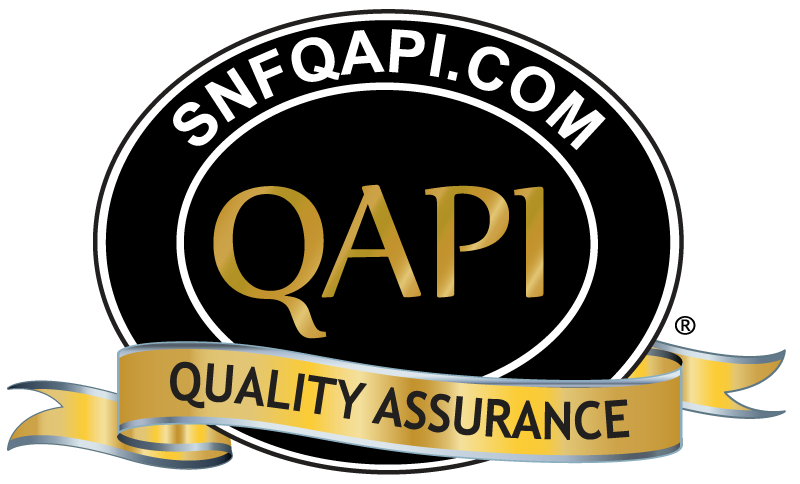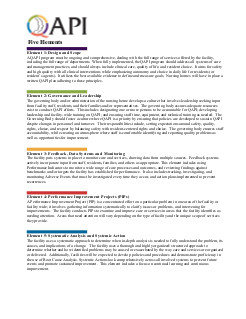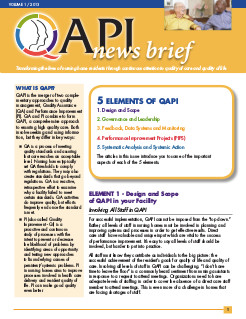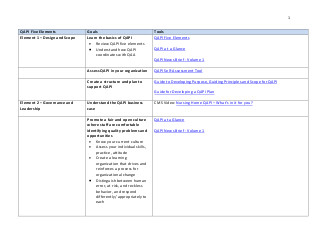Five Elements of QAPI
Element 1: Design and Scope
A QAPI program must be ongoing and comprehensive, dealing with the full
range of services offered by the facility, including the full range of
departments. When fully implemented, the QAPI program should address all
systems of care and management practices, and should always include
clinical care, quality of life, and resident choice. It aims for safety and
high quality with all clinical interventions while emphasizing autonomy and
choice in daily life for residents (or resident’s agents). It utilizes the
best available evidence to define and measure goals. Nursing homes will
have in place a written QAPI plan adhering to these principles.
https://www.cms.gov/medicare/provider-enrollment-and-certification/qapi/downloads/qapiataglance.pdf

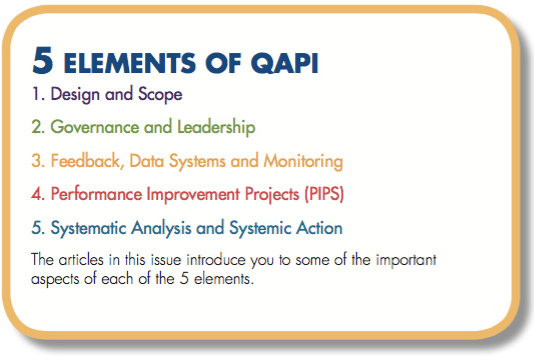
WHAT IS QAPI?
QAPI is the merger of two complementary approaches to quality management, Quality Assurance (QA) and Performance Improvement (PI). QA and PI combine to form QAPI, a comprehensive approach to ensuring high quality care. Both involve seeking and using information, but they differ in key ways:
- QA is a process of meeting quality standards and assuring that care reaches an acceptable level. Nursing homes typically set QA thresholds to comply with regulations. They may also create standards that go beyond regulations. QA is a reactive, retrospective effort to examine why a facility failed to meet certain standards. QA activities do improve quality, but efforts frequently end once the standard is met.
- PI (also called Quality Improvement - QI) is a proactive and continuous study of processes with the intent to prevent or decrease the likelihood of problems by identifying areas of opportunity and testing new approaches to fix underlying causes of persistent/systemic problems. PI in nursing homes aims to improve processes involved in health care delivery and resident quality of life. PI can make good quality even better.
ELEMENT 1 - Design and Scope of QAPI in your Facility
Involving All Staff in QAPIFor successful implementation, QAPI cannot
be imposed from the “top down.” Rather, all levels of staff in nursing
homes must be involved in planning and improving systems and processes
in order to get effective results. Direct care staff have valuable and
unique input which are vital to the success of performance improvement.
It’s easy to say all levels of staff should be involved, but harder to
put into practice.
All staff must know they contribute as individuals to the big picture:
the successful achievement of the resident’s goals for quality of life
and quality of care. Involving all levels of staff in QAPI can be
challenging. “I don’t have time to leave the floor” is a commonly heard
sentiment from nursing assistants in response to a request to attend
meetings. Organizations need to have adequate levels of staffing in
order to cover the absence of a direct care staff member to attend
meetings. This is even more of a challenge in homes that are facing
shortages of staff. Nursing assistants may not be accustomed to voicing
their opinions in the company of directors, supervisors, physicians,
and other senior nursing home staff. Let direct care staff know that
their experiences with the residents are invaluable to the QAPI
process. Their hands-on knowledge of the resident and the day-to-day
processes of the nursing home are necessary to the QAPI discussion and
planning.

|
QAPI Five Elements |
Goals |
Tools |
|---|---|---|
|
Element 1 – Design and Scope |
Learn the basics of QAPI
|
QAPI Five Elements QAPI at a Glance QAPI News Brief - Volume 1 |
Assess QAPI in your organization |
QAPI Self-Assessment Tool | |
Create a structure and plan to support QAPI |
Guide to Developing Purpose, Guiding Principles and Scope for QAPI Guide for Developing a QAPI Plan |
